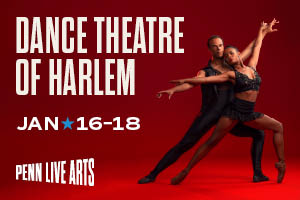Allora & Calzadilla: Intervalsconcluded in early April and featured films, live performances, sound installations and visual art displays and spanned multiple institutions, including The Fabric Workshop and Museum and the Philadelphia Museum of Art. Philadelphia native Jennifer Allora and Cuban-born Guillermo Calzadilla are currently based in Puerto Rico.
One component of the massive project was a live performance featuring three vocalists from acclaimed Philadelphia chamber choir The Crossing. They performed Lifespan, a piece for three whistlers composed by David Lang in collaboration with Allora and Calzadilla, three times a day for the duration of the exhibit, for a total of more than 300 performances at The Fabric Workshop and Museum (FWM). The piece centers on a 4.5 billion year old rock obtained from Puffin Island, off the coast of Canada, one of the few places where there’s relatively easy access to the Earth’s mantle. The rock is suspended from the ceiling, and the performers, Crossing members Colin Dill, Rebecca Siler, and Steven Bradshaw, circle the small, black object and create sounds in the process of whistling at it.
I was taken by the depth of the work, along with the physical practice and impressive endurance of the whistlers. I interviewed vocalist Bradshaw to find out more about his experience from within Lifespan.
The physical practice
When asked about the training process for the work, Bradshaw explained that much of the learning centered around breath control. “In the very beginning before our bodies were used to doing it, we would have a lot of these near white out moments, especially in these long rehearsal sessions. We were still trying to make the piece jump off the page and the respiratory part would get us very dizzy. But you’d be amazed what you can get used to.” He’s also noticed unexpected new capabilities: “It has actually changed what my mouth does. I can achieve these weird whistle tones that I was never able to do before. I think this piece has migrated my dental geography.”
On the structure of the piece
I was curious about the written score for the work, as I wasn’t sure how much was improvised and how much had been previously composed. It turns out that it’s something of a hybrid. “There’s room to make your own decisions within the piece but you’re adhering to a set of ideas and an arc.” Lifespan is written in 34 cells. One cell could be comprised of two measures of music. “You can sing out of rhythm, out of order of pitches, you toss them into the soup, and create a soupy texture with those two measures of music and you exist in that cell for a while.” Each performance would have a different vocalist acting as the leader. “The first person jumps to the new cell and the other two linger. Then eventually they move on and that’s how you move through the cells together.”
Before and after
Bradshaw’s involvement in Lifespan started when he got a call from The Crossing’s conductor Donald Nally asking if he could whistle. That was a quick answer, but the scope of the project caused a double-take. “When Donald called to tell me about it, he had to tell me twice. It’s three times a day every day for four months straight and we’re whistling at a rock? It’s so grandly insane you have to count me in.”
More than 300 performances later, Bradshaw is still interested in the work, and still really likes it. “I’m really convinced by the piece. I like the fact that it’s a piece for voice that’s all white noise and whistle tones.” Nonetheless, he expressed surprise that there was still an audience at the end of the run. “I expected by the end that nobody would be there. It’s a subversive piece of work, it’s not some guy singing oldies.” The composer left a reminder on the score itself to make sure the performers maintained the intended subversive edges. “At the top of the score, it says in big, bold letters [written by David Lang], ‘this is not a gentle piece.’ You could turn it into soft, ambient music with birds and gentle winds, and that’s not what this is. This is a heavy piece.”
Easy format
Both Bradshaw and I were taken with the format of the performances, enabling museum visitors to take a low-risk chance with an unknown piece of work. As Bradshaw put it, “I love the model of, ‘hey, we’re doing this piece of concept art. You show up, it’s 10 minutes, it’s free, it’s at the same spot, it’s the same thing every day for a long period of time. Stop in, reckon with this weird piece of concept art, and then go about your day.’ It’s both gallery art and a musical performance. And in the meantime we’re getting musicians paid in a consistent way. I love the model; I would love to see more projects like this. It’s not much of an investment for the audience member. You could hate it with the power of a thousand suns, and really what have you lost?”
The vocalist noted, “I have no idea what it’s like to watch the piece.”
For me, it was something like this:
It’s a white room with light wooden floors.
If you show up late, you will not be let in.
Three vocalists wearing street clothes approach the rock and start making noise.
It’s surprisingly loud.
You think maybe you are in an art gallery aviary.
You think of Anna Halprin and her formula that dance = breath made visible.
These vocalists are air masters.
You can see their bellies move, throats vibrating, cheeks filling with air.
They seem very strong.
Powerful, even though their exertions don’t matter much to the rock.
Sometimes I would forget the futility,
Urging them to get closer, try harder.
There’s no melody, it’s not linear.
Something timeless, out of the slipstream.
It has the feel of a ritual.
Sometimes one performer will slowly back away from the rock,
creating a vortex of breath around the stone.
Or there is a sharp punctuated breath.
Sometimes the rock sways a few inches, sometimes it’s still.
The whistlers are in slow but continuous movement.
What are they doing with that rock?
It doesn’t seem like they’re trying to move it exactly.
They’re trying to understand it?
Enchant it?
Lull it to sleep?
It’s a mating call to a rock.
They’re cooing a bit,
or they might be angry at it, telling that rock off.
Maybe they’re scientists, their focus always on the rock.
They never touch it.
It’s very analog.
All yearning, breathing,
What could be more analog than our breath?
You’re sitting in a gallery but thinking of being outside.
Sounds of frogs, crickets, it’s probably summer somewhere.
Becoming aware of the earth spinning
Nothing is ever completely still
Time is always passing,
Earth is always rotating.
Time and space are actually linked in a way I hadn’t noticed before.
We are singing to ourselves,
To our own history,
Even as we hurtle forwards.
There’s a good-bye kiss of a breath.
The rock is still moving as they exit.
Lifespan, The Crossing, David Lang, Allora & Calzadilla, Fabric Workshop and Museum, December 12, 2014–April 5, 2015.






